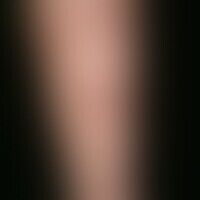Image diagnoses for "Plaque (raised surface > 1cm)", "Leg/Foot"
181 results with 457 images
Results forPlaque (raised surface > 1cm)Leg/Foot

Granuloma anulare disseminatum L92.0
Granuloma anulare disseminatum: non-painful, non-itching, disseminated, large-area plaques that appeared on the trunk and extremities of a 52-year-old patient. No diabetes mellitus. No other systemic diseases known.

Hypertrophic Lichen planus L43.81
Lichen planus verrucosus: grouped, red, itchy, plaques that have existed for several months with a roughened, verrucous surface.

Primary cutaneous diffuse large cell b-cell lymphoma leg type C83.3
Primary cutaneous diffuse large-cell B-cell lymphoma leg type: Detail magnification: Approx. 4-5 cm diameter, irregularly shaped, bulging, deep red tumor with smooth surface of a 75-year-old patient.

Nevus melanocytic congenital D22.-
Nevus, melanocytic, congenital. 6 x 4 mm large, brownish pigmented nevus in the area of the left small toe in a 3-month-old girl. Regular clinical control is necessary. Excision planned at the age of >10 years.

Hypertrophic Lichen planus L43.81
Lichen planus verrucosus with transition into a lichen palnus ulzerosus: verrucous and hyperkeratotic lichen planus of both feet and lower legs, existing for several years, and for several months flat deep ulcers without any healing tendency.

Primary cutaneous diffuse large cell b-cell lymphoma leg type C83.3
primary diffuse diffuse large cell B-cell lymphoma leg type: for about2 years papules and nodules on the left leg of a 55 years old woman appearing in relapses. in the last weeks rapid growth of the pre-existing nodules and eruptive appearance of new nodules. initially no symptoms. since 2 months increasing tendency to dry and also weeping surface scaling. in places complete decay of the nodules.

Sarcoidosis of the skin D86.3
Sarcoidosis, plaque form: slightly pressure-painful plaques of the skin with plates with a scaly surface that can be easily distinguished from the surrounding area and can be moved on the support.

Primary cutaneous diffuse large cell b-cell lymphoma leg type C83.3
Primary cutaneous diffuse large cell B-cell lymphoma leg type: For about 2 years papules and nodules on the left leg of a 55 years old woman appearing in relapses. In the last weeks rapid growth of the pre-existing nodules and eruptive appearance of new ones. Initially no symptoms. For 2 months increasing tendency to surface scaling and ulcer formation.

Nummular dermatitis L30.0
Nummular dermatitis: chronically active, for several months existing, approx. 6 cm large, raised, partly eroded, partly crusty plaques in a 45-year-old man. The surrounding skin is reddened.

Nevus melanocytic congenital D22.-
Nevus melanocytic congenital: large, congenital, hairy melanocytic nevus. No changes during the annual clinical controls. Inlet: reflected light microscopy.

Necrobiosis lipoidica L92.1
Necrobiosis lipoidica: chronic, sharply defined, flat, centrally atrophic, smooth plaque with clearly brown-red tinged edges; shining through of the underlying veins is characteristic.

Granuloma anulare erythematous L92.0
Granuloma anulare erythematous type. little indurated, marginal reddish-brown plaque with indicated central atrophy. slow centrifugal growth lasting for months. Granulomatosis disciformis chronica et progressiva is to be considered as a differential diagnosis (entity).

Nummular dermatitis L30.0
Nummular Dermatitis: General view: For 3 years persistent, itchy, eroded, excoriated, partly encrusted, coin-shaped plaques on the left lower leg of a 64-year-old female patient.

Dermatitis contact allergic L23.0
Dermatitis contactallergic. typical for the allergic pathogenesis of eczema is the blurred, scattering limitation of the inflammatory zone.

Nontuberculous Mycobacterioses (overview) A31.9
Mycobacteriosis, atpic. lymphatic (sporotrichoid) spread of painless red nodules.

Hypertrophic Lichen planus L43.81
Lichen planus verrucosus. numerous, chronically stationary, 1-4.0 cm in size, rough, brownish or brownish-red, rough, wart-like plaques as well as severe itching. scarring after healing

Tinea pedis (overview) B35.30
Tinea pedum: discrete, well defined, heart-shaped, slightly scaly erythema and hyperkeratosis on the right foot back of an 80-year-old female patient with exacerbated tinea pedum.

Circumscribed scleroderma L94.0
Circumscripts of scleroderma (small-heart plaque or confetti type): disseminated, symptomless, 0.1-0.2 cm large, confetti-like, white spots/papules with (incident light microscopic) detectable, atropically shiny surface. The skin lesions have now been discovered (by chance) after sunbathing. Histology: No evidence of Lichen sclerosus.

Hypertrophic Lichen planus L43.81
Lichen planus verrucosus. solitary, chronically stationary, for months unchanged, very itchy, 5.0 cm large, rough, red, verrucous plaques on the lower leg. a highly chronic course over years is to be expected.

Lichen sclerosus extragenital L90.0
Lichen sclerosus extragenitaler: white plaque with a shiny surface, existing for several months, completely without symptoms, slowly progressive; differential diagnosis is to exclude a morphea (histological confirmation).

Tinea cruris B35.8
Tinea cruris: chronic plaque that is slightly faded in the centre, accentuated at the edges, covering a large area and moderately itchy.



